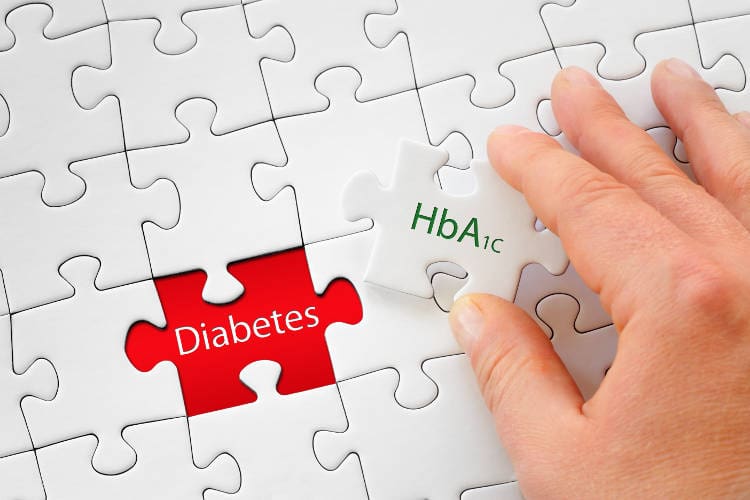The HbA1c test is a useful, simple and inexpensive blood test that can be used to diagnose diabetes and also to monitor blood glucose control in people with known diabetes.
HbA1c stands for glycated haemoglobin, or glycosylated haemoglobin. An HbA1c blood test can give an indication of whether blood glucose levels have been higher than normal over the last few months, by looking at how much sugar (glucose) is bound in your red blood cells.
What is glycated haemoglobin?
Your red blood cells contain a protein called haemoglobin (Hb) which carries oxygen. Sugar (glucose) in your bloodstream can combine with the haemoglobin in red blood cells, forming glycated haemoglobin. Even people with normal blood glucose levels have some glycated haemoglobin in their blood, but if you have consistently high blood glucose levels, a higher proportion of red blood cells will have glycated haemoglobin. The HbA1c test measures the percentage of all haemoglobin that is bound to glucose.
The HbA1c level reflects the average blood glucose levels from the last 3 months or so. That’s because once glucose has attached to haemoglobin in a red blood cell, it stays there for the life of the red blood cell, which is around 3 months.
Why is this test done?
Doctors usually recommend that people with diabetes have an HbA1c test about every 3-6 months, as it gives an indication of the overall control of blood glucose levels over the previous 8-12 weeks. A raised HbA1c correlates with an increased risk of developing diabetes complications such as diabetic retinopathy.
HbA1c testing is used in addition to home blood glucose monitoring (which shows day to day blood sugar highs and lows) to help give a picture of whether your diabetes treatment is effective.
More recently, HbA1c tests have also been approved to be used in the diagnosis of diabetes.
How is the test done?
The HbA1c test is a simple blood test. The blood can be taken by your doctor or at a pathology lab. There is no need to fast before the test – you can eat and drink as normal. The results should be available within 24 hours.
What does HbA1c measure?
The test measures the percentage of haemoglobin that is bound to glucose, which reflects the average blood glucose concentration over last few months.
Glycosylated haemoglobin can be measured:
- as a percentage; or
- in units of mmol/mol, which is a newer way of measuring and reporting HbA1c results.
What’s a normal result for HbA1c?
A normal HbA1c result is between 3.5 to 6 per cent (15-42 mmol/mol).
What’s a bad HbA1c result?
Abnormal results (which would be higher than the normal range) indicate a possible diagnosis of diabetes or poor control of diabetes.
HbA1c to diagnose diabetes
If you are having an HbA1c test to help diagnose diabetes, a result of 6.5 per cent (48 mmol/mol) or higher is diagnostic of diabetes. A repeat test is often recommended to confirm the result, especially if you have no symptoms.
Your doctor will also want to talk with you about your lifestyle, such as your diet and how much physical activity you usually do.
People with known diabetes
If you have known diabetes and your HbA1c is 6.5 to 7 per cent (48-53 mmol/mol), your blood glucose control over the last few months would be considered to be good. Most doctors would recommend that people with diabetes should aim for this range. However, some people may have a target HbA1c range that is slightly higher than this.
If your levels are higher than your target range, that means that your blood sugar levels probably have not been well controlled recently. Your doctor will want to talk to you about your current treatments and whether any adjustments need to be made.
What is the benefit of HbA1c over other diabetes tests?
HbA1c is a simple blood test that does not require any fasting or other special preparation beforehand, and can be done at any time of the day.
This is compared with other tests that can be used in the diagnosis of diabetes. A fasting blood sugar level, as the name implies, requires you to fast (not eat food or drink) for a certain period of time before having the blood test.
An oral glucose tolerance test is another way to diagnose diabetes. It requires a special diet for 3 days before having the test, and then fasting overnight before the test. This test also involves having several blood tests over a couple of hours – before and after having to drink a certain volume of sweet liquid. The test is time consuming and some people find that drinking the liquid can make them feel sick.
Does a high HbA1c always mean diabetes?
No. There are some things other than diabetes that can affect HbA1c levels.
Most of us have type A haemoglobin (HbA, or adult haemoglobin), but some people have a variant form of haemoglobin. This is known as a haemoglobinopathy, and it can cause falsely high or low HbA1c results.
Iron deficiency and iron deficiency anaemia can give a falsely high result; and haemolytic anaemia, blood loss, chronic (ongoing) liver disease and chronic kidney disease can give a falsely low HbA1c result.
There are also some medicines and supplements that affect the results, including:
- iron, vitamin B12 and folate supplements;
- erythropoietin therapy;
- aspirin treatment;
- vitamin C or E supplements; and
- certain antiviral and antimicrobial medicines.
Your doctor will check before doing the test whether you have any factors that could alter the results.

